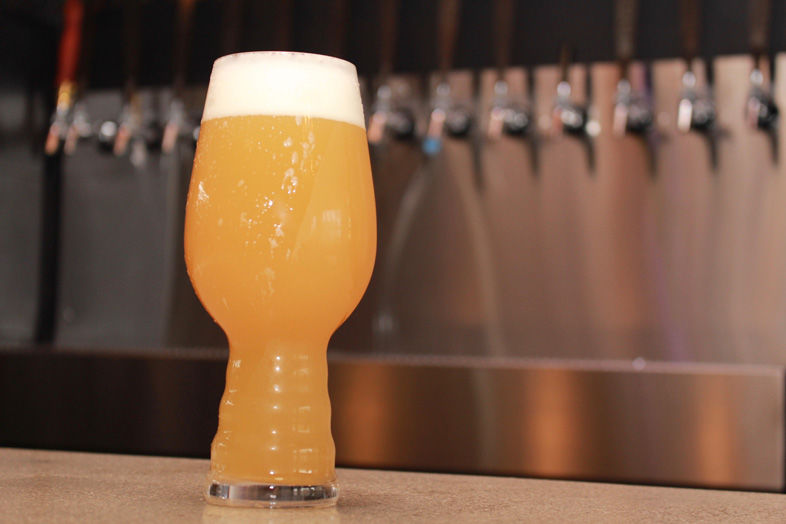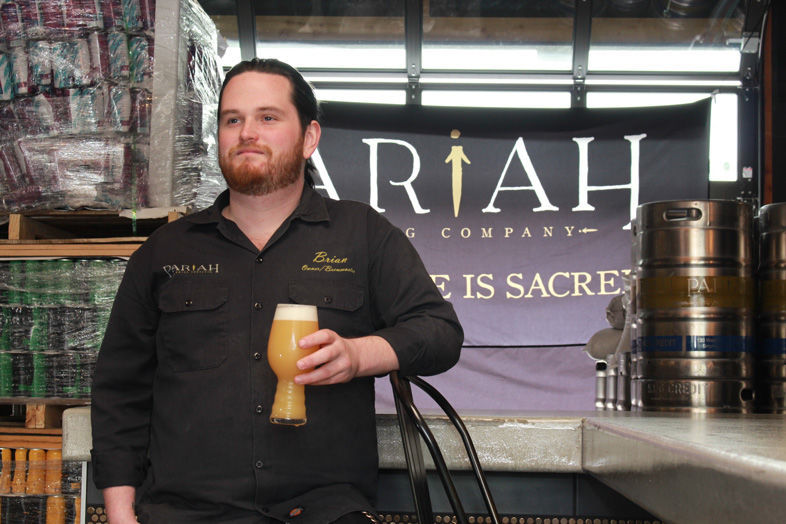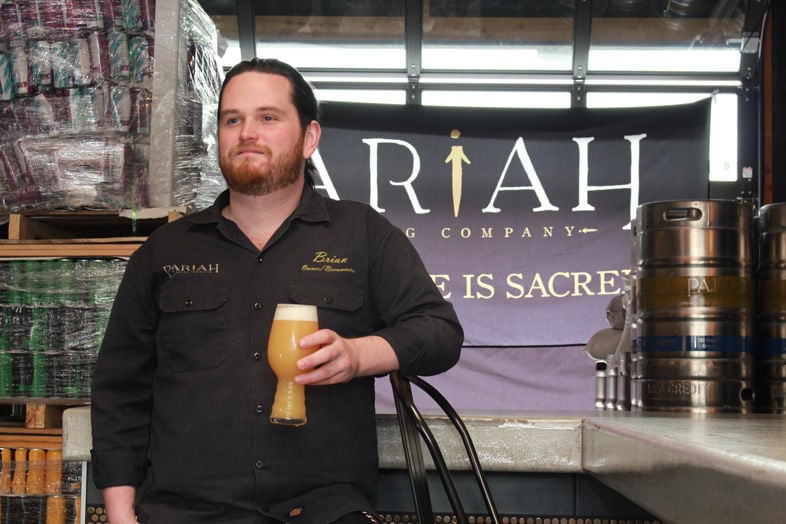A brewer can learn a lot from running a business for two years. In San Diego particularly, a brewer learns how to cope with intense competition in a marketplace overrun with top-quality beer. Brian Mitchell has learned a great deal since he and his team opened their small brewery, Pariah, in North Park back in 2017. Above all, he’s learned that one has to evolve in order to survive.
Sipping on a fresh pint of Galaxy-laden LeBron Haze IPA, I sat down with Brian to talk about the journey he’s taken over the past two years—and how it has defined Pariah’s brand now.
You just had your two-year anniversary—what do you feel were the biggest changes from Year 1 to Year 2?
We had a lot of changes in Year 2, actually. A lot of Year 1 was trying to force our way into a situation that we wanted to be in and we kind of got our butts kicked because of it.
How so?
We were trying to tell people what they wanted to drink, versus listening to them telling us what they wanted to drink. I was very bullheaded in terms of saying, “This is awesome. You will love this,” instead of realizing that beer is for sale. People have to want to buy it!
That’s one of the toughest transitions a brewer can make initially, right? You get into it to brew what you love and what you want to drink, but then you realize quickly that if you want to be in a business, it’s got to be a compromise between what people want to drink and what you want to make.
Absolutely. And a lot of Year 2 was us exploring that. Especially in terms of figuring out what we wanted to do and how to still do it our own way. Year 2 was also a lot about internal culture and team adjustments on our end.
Let’s talk about each of those things. What were some of the beer changes?
Well, coming from Stone, I was definitely coming with a West Coast mentality when it came to brewing our IPAs, and a lot of people were saying our beers were too bitter. So I had to learn how to make this new style of IPA, which is probably the style of beer I feel least accomplished at. I kind of got that playbook and ran with it. In terms of my IPA making, I had to scrap the previous methods and start from the ground up. I had to learn how to make the IPAs that people are making today.
So, lower bitterness and bigger, juicier character?
Yup. And it took a lot. Partly because originally a lot of those styles I didn’t really care for. Not only that, I think I was pretty outspoken about being against them. I think a lot of older guys who have been around for a while were upset about it. But once you try them, you realize that these beers are beautiful. There’s nothing to hate. I don’t get down with the milkshake IPA thing, but a proper New England–style IPA is a beautiful beer.
Which beers did you try that really changed your mind?
Trillium’s Fort Point Pale Ale was definitely eye opening, and Tree House’s Green IPA was like, “Whoa! This is amazing.” Here in town, Dan Drayne at Half Door is killing it with his hazy beers. Modern Times Space Ways was incredible. That beer pissed me off, it was so good. It made me say, “I wish I came up with this beer!” A lot of it was the 2018 crop of Nelson that they used, which is unbelievably good.

Have a Beer With Pariah Brewer Brian Mitchell
IPAs of various styles, like this hazy, now make up about half of Pariah’s tasting room tap list. | Photo: Bruce Glassman
A lot of the changes were about reorienting your approach to IPAs. Have the other styles largely stayed the same?
Yes. We really haven’t changed much else at all. We still have our witbier, we still have our Erotic City, we still have our Uni Stout. So it really was just basically IPA. And sours as well. A lot of people were asking for sours and we didn’t have them.
You mentioned that a lot of Year 2 was also about retooling the culture. What was that about, specifically?
We had a couple of bad eggs early on that we needed to weed out. And we had to figure out who we were going to be—not only as brewers or distribution people, but as owners. To figure out what we were going to expect from staff and from ourselves. That was difficult. And we’re still learning how to get people up to speed and have training and accountability—all that stuff you need in place so people can be successful, because we need them. I think a lot of people come into this kind of situation saying, “No, I’m the owner and you’re just the staff,” and that’s a definite misstep. I mean, I’m good at being a brewer, but I’m not really good at doing social media or HR or any of those other things. So we need people to come along with us, and we needed to figure out how we attract them to this company. We redid our pay structure—we’re a living wage employer—and we’re now more than 50 percent female. So it’s been a lot of that. How do we attract talent? How do we train talent? And how do we grow with them?
Did you get any insight or advice from other brewers that helped you evaluate the changes that needed to be made?
Sort of. I’d always heard from brewers that, if you make great beer, everything else will work itself out. A lot of people say that, but I found that couldn’t be further from the truth! Making great beer and saying you’re open doesn’t mean people are coming in the door. It doesn’t mean people are going to “get it.” And it doesn’t mean your staff is going to be accommodating to your guests. Making great beer: That’s only step one.
What are some of the other things from the past year that you’re particularly proud of?
Well, we’ve gotten a lot of recognition in the past year for our beers, which is always nice to see. I personally try not to pay too much attention to reviews, because I feel we still have a lot of work to do. So it’s nice and we’re thankful to be acknowledged—especially in this town—as someone who’s doing really well, but we still have a lot of work to do.
Are there new directions and things you want to tackle as you brew into Year 3?
We’re actually talking to a couple of states outside of California. We’ve sent some beer to Washington state, which is really cool. My family’s actually from the Pacific Northwest. And we’re talking to two other states at the moment as well.
Right now, you can your beers with a mobile canning line. Do you package Erotic City?
Not yet, but we actually just got the can design back.
Talk a little bit about what you want your public’s perception to be of Pariah, what you want most for your identity, and how you set yourself apart from everyone else.
For us, we want to make extremely flavorful beer—to the point where it might even be too flavorful for some people. Even offensive.
Offensively flavorful?
Yes. Offensively flavorful! Like we’re not trying to hold back. We do want everything to have a purpose and a balance, but we really want to not be timid in terms of what we do. We also want to be a place that’s cool; a place to hang out in. We do our Art Nights, and a lot of musicians come in and hang out in here, and that’s really cool. We want to have an upscale type of service, but in a relaxed, welcoming atmosphere with delicious beer. As a company, I hope people come to see us as a place that’s really good to its staff, that is a really positive aspect of the community and gives back to it.
What’s the one thing you want people to know about your beers that you don’t think they know right now?
We’ve taken a new approach to our IPAs, but we’re also doing a lot of things the same as we always have. We still like getting weird and we still like getting crazy!
ERRATA: In last week’s post, the list of Stone Distributing Company’s top-selling brands inadvertently omitted Mother Earth Brew Co., which is in the top five.

Have a Beer With Pariah Brewer Brian Mitchell
PARTNER CONTENT
Pariah Brewer Brian Mitchell heads into Year 3 with some new ideas and a re-tooled beer lineup | Photo: Bruce Glassman















